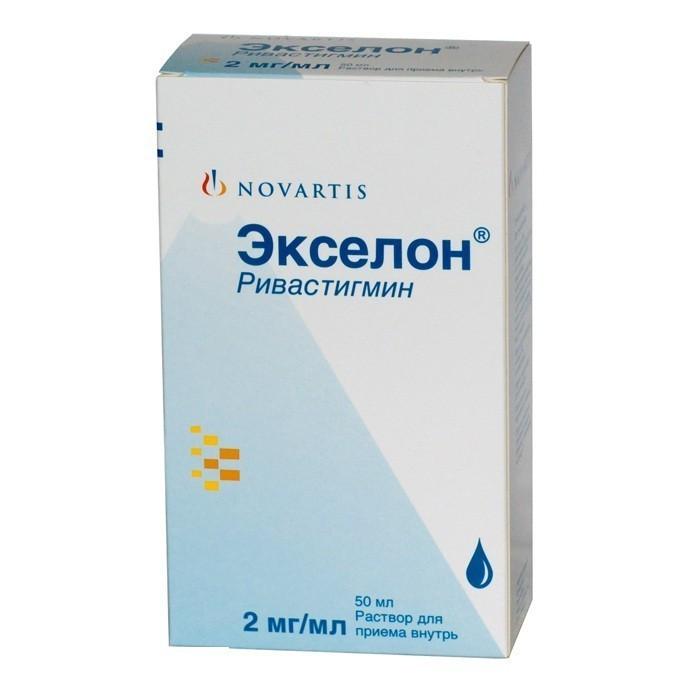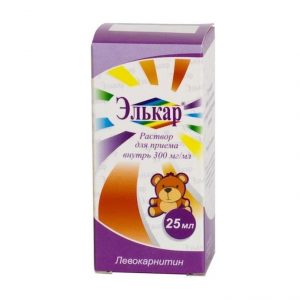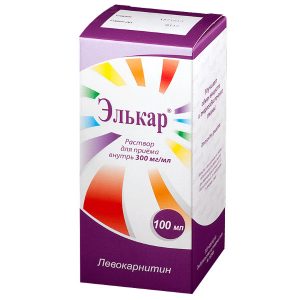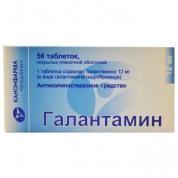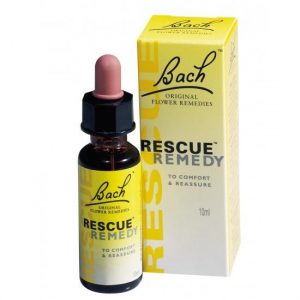Description
Latin name
Exelon
oral solution
oral solution
Packaging
Bottle 50 ml.
Indications
– Mild or moderate Alzheimer’s type dementia (probable Alzheimer’s disease, Alzheimer’s disease).
– Mild to moderate dementia in Parkinson’s disease.
Contraindications
– Hypersensitivity to rivastigmine, other carbamate derivatives, or other components of the drug.
– Exelon is contraindicated in patients with severely impaired liver function, since its use in this population has not been studied.
Use during pregnancy and lactation
The safety of Exelon during pregnancy in humans has not yet been established, therefore, the drug can be prescribed during pregnancy only when the expected treatment success exceeds the potential risk to the fetus. It is not known whether rivastigmine is excreted in breast milk. Therefore, during the use of the drug should abandon breastfeeding. Experimental studies have shown that rivastigmine does not have teratogenic properties.
Composition
1 ml. contains: Active ingredient: rivastigmine (in the form of hydrotartrate) 2 mg
Excipients: sodium benzoate, citric acid, sodium citrate, choline yellow (E104), purified water.
Dosage and administration of
Exelon should be taken 2 times / day, during breakfast and dinner.
The initial recommended dose is 1.5 mg 2 times / day. When using the drug in patients particularly sensitive to the effects of cholinergic drugs, treatment should begin with the use of the drug in a dose of 1 mg 2 times / day.
Dose selection: the initial recommended dose is 1.5 mg (0.75 ml of solution) 2 times / day. If after a minimum of 2 weeks of treatment there is good tolerance to this dose, it can be increased to 3 mg (1.5 ml of solution) 2 times / day. If the dose taken by the patient is well tolerated, its further increase is possible – up to 4.5 mg (2.25 ml of solution) 2 times / day and then up to 6 mg (3 ml of solution) 2 times / day – with an interval of at least 2 weeks after each dose increase .
Adverse events, namely nausea, abdominal pain, loss of appetite or weight loss, observed during treatment may decrease after skipping 1 or more doses of the drug. If adverse events persist, the daily dose should be reduced to the previous dose well tolerated by the patient.
Maintenance dose is 1.5 to 6 mg 2 times / day. In order to achieve the best therapeutic effect, the dose should be kept at the maximum well tolerated level.
The maximum daily dose is 12 mg (6 mg 2 times / day).
Resumption of the drug after a break. If the break in taking the drug was several days or more, treatment should be resumed from the initial dose to reduce the risk of resuming adverse reactions (for example, severe vomiting). A gradual increase in dose is carried out stepwise, as described above.
In patients with impaired renal or hepatic function, dosage adjustment is not required.
How to use the solution for oral administration: the required amount of solution should be removed from the vial using the dispenser attached to it. The solution can be taken directly from the dispenser. Equal doses of the drug used in the form of capsules and as a solution for oral administration are interchangeable.
Side effects
The overall incidence of adverse events with TTC Exelon therapy 9.5 / 24 hours (50.5%) was lower compared with oral therapy using capsules in a daily dose of 3-12 mg (63.3%) (for comparison, in the group placebo, the rate was 46%).
The most frequent reaction from the digestive system. Nausea (7.2%) and vomiting (6.2%) were observed much less frequently with the use of TTC Exelon 9.5 mg / 24 h compared with capsules for oral administration, 23.1% and 17.0%, respectively (in the placebo group, the same indicators were 5.0% and 3.3% )
The incidence of adverse reactions in patients (291 people) with Alzheimer’s type dementia, treated with TTC Exelon therapy (all dosages) was determined as follows: very often ( 1/10), often ( 1/100, less than 1/10), infrequently ( 1/1000, less than 1/100), rarely ( 1/10 000, less than 1/1000), very rarely (less than 1/10 000), undesirable reactions are presented separately, the frequency of which is not precisely established.
Infectious and parasitic diseases: often – urinary tract infections.
From the side of metabolism: often – anorexia.
From the nervous system: often – anxiety, depression, delirium, headache, fainting very rarely – extrapyramidal disorders frequency unknown – hallucinations.
From the cardiovascular system: infrequently – bradycardia, cerebrovascular accident.
From the digestive system: often – nausea, vomiting, diarrhea, dyspepsia, abdominal pain infrequently – gastric ulcer.
Dermatological reactions: often a rash.
On the part of the body as a whole and reactions at the site of TTC attachment: often – erythema, swelling and itching, irritation, inflammation at the site of application, increased fatigue, asthenia, fever, weight loss.
In clinical trials when using the drug in doses of more than 9.5 mg / 24 h, the following adverse reactions were noted much more often than in the TTC Exelon 9.5 mg / 24 h and placebo groups: dizziness, insomnia, agitation, decreased appetite, atrial fibrillation, heart failure ( possibly related to an increase in dose). The frequency of these adverse reactions during therapy with TTC Exelon 9.5 mg / 24 h was similar to that in the placebo group.
The following adverse reactions, observed only when treated with capsules or Exelon oral solution and were not registered with TTC Exelon 9.5 mg / 24 h: dizziness (very often), agitation, drowsiness, general malaise, tremor, confusion, increased sweating (often), insomnia , accidental falls, increased liver activity (sometimes), convulsions, duodenal ulcer, angina pectoris, myocardial infarction (rare), arrhythmias (e.g. AV block, atrial fibrillation, tachycardia), increased blood pressure, pa Creative, gastrointestinal haemorrhage, hallucination (very rare), in some cases – severe vomiting, leading to rupture of the esophagus (the frequency is unknown).
Dermatological reactions
When using TTC Exelon, the most frequently observed reddening of the skin (erythema) at the site of application, usually disappearing in most patients within 24 hours. In clinical trials with TTC Exelon 9.5 mg / 24 hours, mild (21.8%), moderate (12.5%), severe (reddening) of the skin, mild itching (11.9%) were noted moderate (7.3%) and severe (5%) degrees.
During therapy with TTC Exelon 9.5 mg / 24 h, pruritus and erythema were observed in 1.7% and 1.1% of patients, respectively. Most skin reactions developed only in the area of TTC application. When using TTC Exelon 9.5 mg / 24 h, discontinuation of drug treatment due to the development of dermatological reactions was noted in only 2.4% of cases.
Drug Interaction
Rivastigmine is metabolised mainly by hydrolysis with the participation of esterases. The metabolism of the drug with the participation of major isoenzymes of cytochrome P450 occurs to a minimum extent. Therefore, expect pharmacokinetic interactions with other drugs, metabolizable with the participation of these enzymes, it is not necessary.
No healthy pharmacokinetic interaction between Exelon and digoxin, warfarin, diazepam or fluoxetine was found in healthy volunteers. Warfarin-induced increase in prothrombin time did not change with the appointment of Exelon. With the simultaneous use of Exelon and digoxin, no adverse effect on intracardiac conduction was noted.
Concurrent use of Exelon with commonly used drugs such as antacids, antiemetic agents, antidiabetic agents, central antihypertensive agents, beta-blockers, calcium channel blockers, positive inotropic agents, drugs with positive inotropic effects antihistamines, was not accompanied by any changes in the kinetics of Exelon or an increase in the risk of adverse events.
Exelon, as a cholinesterase inhibitor, can potentiate the action of depolarizing muscle relaxants (succinylcholine type muscle relaxants) during anesthesia.
Overdose
An accidental overdose of the drug in most cases was not accompanied by any clinical manifestations, almost all of these patients continued treatment with Exelon.
Symptoms: nausea, vomiting, diarrhea, marked increase in blood pressure, hallucinations. Given the vagotonic effect of cholinesterase inhibitors on heart rate, bradycardia and / or syncope cannot be ruled out. In one case, 46 mg of the drug was taken after conservative treatment after 24 h complete recovery was observed.
Treatment: since the plasma half-life of rivastigmine is about 1 h and the duration of acetylcholinesterase inhibition is about 9 h, in cases of asymptomatic overdose, it is recommended not to use Exelon for the next 24 hours. If overdose is accompanied by severe nausea and vomiting, the use of antiemetic agents should be considered. If necessary, conduct symptomatic therapy.
Atropin sulphate can be used with a significant overdose, the initial dose of which is 0.03 mg / kg / kg and subsequent dosing depends on the clinical effect. The use of scopolamine as an antidote is not recommended.
Storage conditions
The drug should be stored out of the reach of children at a temperature not exceeding 30 ° C.
The Expiration of
is 3 years.
Deystvuyuschee substances
rivastigmin
pharmacy terms for prescription
dosage form
oral solution
Novartis Farma Stein AG, Switzerland
